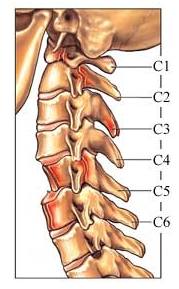Fracture of neck
Description broken neck
Fracture of neck – failure of one or more of the cervical bones (the vertebrae in the neck). Vertebrae – bones, consisting backbone.
Fracture of neck – very serious injury, which may lead to paralysis or death. A man with no neck injury should not be moved without skilled medical care, which should be provided as soon as possible.
It is important to promptly recognize a broken neck. Serious injuries, eg, head injury, often also cause the destruction of the cervical vertebrae.

Causes of neck fracture
The destruction of the vertebrae is the result of a strong neck injury. Causes include injury:
- Drop, eg, a horse or bike;
- Crash;
- Diving into the water in the shallows;
- Strong and unexpected twist of the neck;
- A strong blow to the head or neck.
Risk factors for a neck fracture
Factors, increase the risk of neck fracture include:
- Age 65 and older;
- Reduced muscle mass;
- Osteoporosis;
- Certain contact sports, eg football;
- Violence;
- Driving without a seat belt in the car;
- Head injury or other traumatic injury, such as severe chest trauma, pelvis and femur.
Symptoms of a broken neck
Symptoms include:
- Pain in the neck, which can be very strong and almost felt;
- Swelling and bruising;
- The sensitivity of the neck;
- Reduced sensitivity in the hands or feet;
- Muscle weakness or paralysis of the arms or legs.
Diagnosis of a fracture of the neck
The doctor will ask about your symptoms, About, how the accident occurred, and will examine the injured area.
Tests may include:
- Roentgen – examination, which uses X-rays, to take a picture of structures inside the body, especially bones. It is used to search for bone fracture or dislocation of the vertebrae;
- MRT – examination, that uses a strong magnetic field and radio waves, to make pictures of structures inside the neck and back. MRI provides the mapping of the cross-sectional, that allows the doctor to see, whether there is damage to the spinal cord;
- CT – type of X-ray, which uses computer, to make pictures of structures inside the neck and back. It can be used for analysis of bone injuries and allows seeing, whether the spinal cord is compressed by the accumulation of blood in it.
Treatment of fractures of the neck
Treatment depends on the:
- The severity of the fracture;
- The presence of associated dislocation or instability of the vertebrae;
- Damage of the spinal cord or surrounding nerves, muscle weakness or paralysis.
Treatment includes:
Immobilization of the neck
When there is a possibility, need complete immobilization of the neck area. Athletes are recommended to use a helmet and shoulder pads on while immobilizing the spine.
Bondage collar or neck fracture
With simple fractures of the neck can be used neck brace or collar. It should be worn until complete healing of the bones of the neck, usually, from 8 to 12 weeks. Your doctor may recommend drugs, to reduce pain and swelling from an injury.
The operation at the turn of the neck
For severe fractures, perhaps, need surgery, that restore bone. Before surgery, the neck can be immobilized. They can be used with sheet metal screws or other fixation methods to hold bone together.
Exercises at the turn of the neck
When a doctor decides, bones strong enough, to start to do the exercises to improve range of motion and strengthen the muscles. This may require the assistance of a physiotherapist. Ask the doctor, when you can return to physical activity, as well as the removal of restrictions and other precautions.
Healing time of fracture of the neck
Maybe, You will need to wear a tire, bandage or surgical collar for several months. The period of rehabilitation can last many months and even years.
Living with paralysis
Neck fracture can sometimes result in spinal cord injury, Nerve and Paralysis. This may require significant changes in life, including work, family, social networks. You may need serious rehabilitation, including physiotherapy, occupational therapy, and psychological support.
Preventing neck fracture
To prevent the fracture of the neck:
- Do not put yourself at risk of injury of the cervical bones;
- Always wear a seat belt while riding in a car;
- Take extreme caution when participating in sports or at work;
- Never dive in the shallow pool;
- Never dive into water, if you do not know the depth or the bottom may be obstacles;
- Eat a diet, rich in calcium and vitamin D;
- Perform exercises to strengthen bones;
- Train your muscles, to prevent falls and to stay active and agile.
